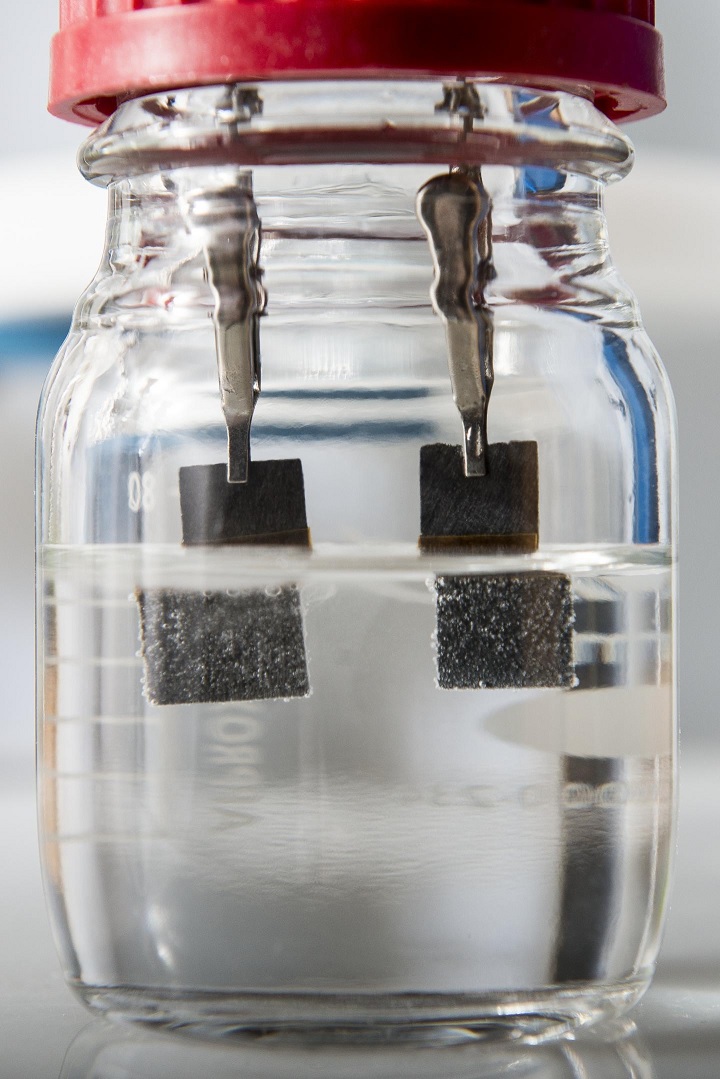In the hunt for a device capable of supplying clean-burning hydrogen fuel, Stanford University scientists have invented a low-cost water splitter that produces both hydrogen and oxygen.
The low-voltage, single-catalyst water splitter based on lithium-ion battery technology can generate the two gases continuously for over 200 hours, the paper describing the device published in Nature Communications reveals. This, the scientists say, will pave way for continuous supply of clean-burning hydrogen fuel for transportation and industry.
The breakthrough of the technology is that Yi Cui, an associate professor of materials science and engineering at Stanford and of photon science at the SLAC National Accelerator Laboratory and his colleagues created one low-cost catalyst capable of driving the entire water-splitting reaction.
“Our group has pioneered the idea of using lithium-ion batteries to search for catalysts,” Cui said. “Our hope is that this technique will lead to the discovery of new catalysts for other reactions beyond water splitting.”
Clean hydrogen has long been seen as a viable and emissions-free alternative to gasoline, but commercial-grade hydrogen that can be used as fuel has always been made from natural gas. Though there have been research in the field of making hydrogen from water, the technology has always remained expensive because of the rare metals used as electrodes in water-splitting devices.
However, this all changed when in 2014, Stanford chemist Hongjie Dai developed a water splitter made of inexpensive nickel and iron that runs on an ordinary 1.5-volt battery. In the latest study, Cui and his colleagues have taken the technology one step further.
The new water splitter is unique for the fact that it uses only one catalyst – nickel-iron oxide – for both electrodes and this bifunctional catalyst is able to produce hydrogen and oxygen by splitting water continuously for more than a week with a steady input of just 1.5 volts of electricity.
“That’s an unprecedented water-splitting efficiency of 82 percent at room temperature”, Cui said.
In conventional water splitters, the hydrogen and oxygen catalysts often require different electrolytes with different pH — one acidic, one alkaline — to remain stable and active. ‘For practical water splitting, an expensive barrier is needed to separate the two electrolytes, adding to the cost of the device,’ Wang said. ‘But our single-catalyst water splitter operates efficiently in one electrolyte with a uniform pH.’
Wang and his colleagues discovered that nickel-iron oxide, which is cheap and easy to produce, is actually more stable than some commercial catalysts made of precious metals.
“We built a conventional water splitter with two benchmark catalysts, one platinum and one iridium,” Wang said. “At first the device only needed 1.56 volts of electricity to split water, but within 30 hours we had to increase the voltage nearly 40 percent. That’s a significant loss of efficiency.”
Marriage of batteries and catalysis
To find catalytic material suitable for both electrodes, the Stanford team borrowed a technique used in battery research called lithium-induced electrochemical tuning. The idea is to use lithium ions to chemically break the metal oxide catalyst into smaller and smaller pieces.
‘Breaking down metal oxide into tiny particles increases its surface area and exposes lots of ultra-small, interconnected grain boundaries that become active sites for the water-splitting catalytic reaction,’ Cui said. ‘This process creates tiny particles that are strongly connected, so the catalyst has very good electrical conductivity and stability.’
Wang used electrochemical tuning — putting lithium in, taking lithium out — to test the catalytic potential of several metal oxides.
‘Haotian eventually discovered that nickel-iron oxide is a world-record performing material that can catalyze both the hydrogen and the oxygen reaction,’ Cui said. ‘No other catalyst can do this with such great performance.’
Using one catalyst made of nickel and iron has significant implications in terms of cost, he added.
‘Not only are the materials cheaper, but having a single catalyst also reduces two sets of capital investment to one,’ Cui said. ‘We believe that electrochemical tuning can be used to find new catalysts for other chemical fuels beyond hydrogen. The technique has been used in battery research for many years, but it’s a new approach for catalysis. The marriage of these two fields is very powerful. ‘
Other Stanford co-authors of the study are postdoctoral scholar Hyun-Wook Lee, visiting student Zhiyi Lu, and graduate students Yong Deng, Po-Chun Hsu, Yayuan Liu and Dingchang Lin.

